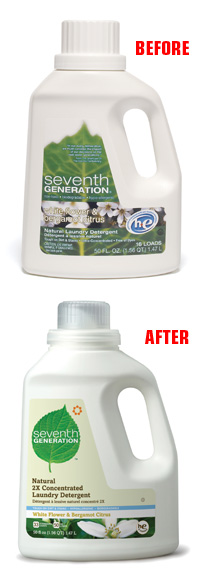Seventh Generation Proves Appearance Does Matter
 Seventh Generation (www.seventhgeneration.com) is committed to becoming the world's most trusted brand of authentic, safe and environmentally-responsible products for a healthy home.
Seventh Generation (www.seventhgeneration.com) is committed to becoming the world's most trusted brand of authentic, safe and environmentally-responsible products for a healthy home. "For us, innovation begins by improving our ability to see our work with a greater level of consciousness," says Courtney Loveman, brandmother for Seventh Generation. "It entails putting our efforts toward making products that aren't merely less bad, but more holistically good, in ways that consider social and environmental progress."
Nature Calls for Differentiation
For 20 years, the company has been at the forefront of a cultural change in consumer behavior and business ethics. But a coming flood of mega-brand entries into its eco-friendly niche recently prompted Seventh Generation to take a consumer-centric approach to updating its packaging designs.
So, for the past three years, Loveman focused on developing a more brand-centric culture within the organization. This task included the establishment of design
standards to improve the consistency and strength of the Seventh Generation brand for consumers through the evolution of its look, feel, voice and attitude.
"We often heard from our most loyal consumers that they appreciated our willingness to provide them with a significant amount of information, whether on our packaging, on our Web site or on the telephone," explains Loveman. "Simultaneously, we heard from existing and new users that the information we were providing was sometimes difficult to find or read."
Consumer feedback also revealed that shoppers recognized the Seventh Generation brand, but not always by name. "They looked for the leaf," reveals Loveman.
Thus, a label evolution project was launched that would incorporate consumer feedback in a way that would improve readability, overall shelf presence, brand recognition (both of the name and logo) and still maintain the company's core values.
Natural Selection
Based on the importance of consumers to the design process, Seventh Generation enlisted an innovative online research technology that relies entirely on consumers to optimize and refine packaging designs.
"We partnered with Affinnova (www.affinnova.com) to use its IDDEA process, which uniquely taps into the opinions and desires of consumers without resorting to the often biased and limited approaches of more traditional qualitative and quantitative research methodologies," explains Loveman.
To prepare for an optimization study, Seventh Generation designers developed a broad range of variations for each of the major design elements such as logo, colors, images and font set.
These variations could be combined into 4,680 alternative package designs using a sophisticated graphics platform that was then subjected to a consumer-driven evaluation. This helped Seventh Generation sort through thousands of options to find the most preferred design concepts -- "a virtual 'natural selection' process," says Loveman.
The company received clear feedback on its top concepts, which indicated the relative importance of various design components and identified latent preferences that helped the company to focus on strengthening brand impact.
For example, before the optimization study was launched, there was an ongoing debate about color palette between the Seventh Generation sales, marketing and design teams.
Should the package retain green as the brand signature and category cue? Or is brown "the new green" that could serve to contemporize the design?
The study showed that consumers evolved to neither, instead indicating a natural/colorless design approach as the top concept.
Seventh Generation products donning the new packaging designs launched in the marketplace in December 2008 and are still being rolled out in some cases.
While Loveman says it is a bit too early to identify measurable results, consumer testing with new moms in the diaper category already revealed high praise for the new look, brand recognition and overall appeal, reports Loveman.
Natural Progression
Seventh Generation's packaging innovation pipeline does not end with its label evolution. The company is working to improve the amount of recycled content in its bottles, and its innovation team is also working to improve the bottle shape with a focus on thoughtful utility rather than aesthetics alone, according to Loveman.
All in all, it is evident that Seventh Generation is working hard to build innovation into all of its processes and projects.
"We believe that we will fail if we don't listen to our customers and consumers," closes Loveman.
